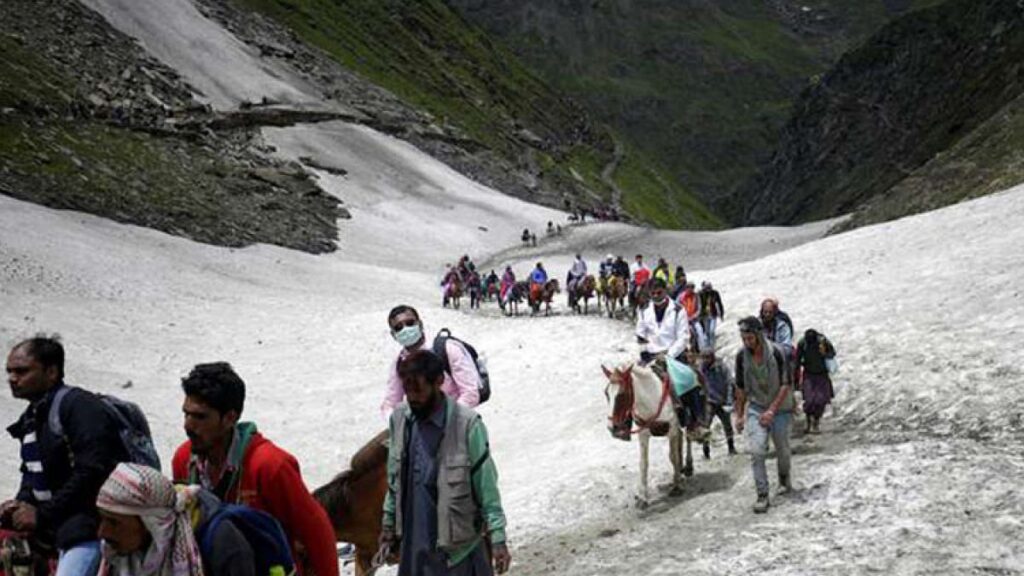The History and Evolution of the Amarnath Yatra

The Amarnath Yatra is a significant pilgrimage in Hinduism that takes place in the state of Jammu and Kashmir, India. It is dedicated to Lord Shiva and involves trekking to the holy cave of Amarnath, located in the Himalayas. The pilgrimage has a rich history and has evolved over time. Below is an extensive account of the history and evolution of the Amarnath Yatra.
Ancient Origins and Mythological Significance: The history of the Amarnath Yatra dates back thousands of years. According to Hindu mythology, it is believed that Lord Shiva revealed the secret of immortality to his wife, Goddess Parvati, in the Amarnath Cave. Legends suggest that a sage named Kashyapa first discovered the cave, and it remained unknown to the world until it was rediscovered in modern times.
The Rigveda, an ancient Hindu scripture, mentions Mount Kailash, believed to be the abode of Lord Shiva. The Amarnath Cave, situated in the Himalayas, is considered a part of this sacred mountain range. The Lingam, a symbolic representation of Lord Shiva, is said to form naturally inside the cave during the pilgrimage season.
Rediscovery of the Cave: The Amarnath Cave was lost to history and remained hidden for centuries until it was rediscovered in the 15th century. According to popular legend, a Muslim shepherd named Buta Malik was given a bag of coal by a holy man. When Malik opened the bag at home, he found it filled with gold instead. Overwhelmed by this miracle, he went in search of the holy man to express his gratitude.
Buta Malik eventually found the holy man, who was actually Lord Shiva in disguise. The holy man led him to the Amarnath Cave and revealed the secret of the cave’s sanctity. When Malik returned to share the story with others, the news spread, and people began to visit the cave to witness the natural ice lingam that formed inside.
Early Pilgrimages and Limited Accessibility: In the centuries following the rediscovery of the cave, the Amarnath Yatra gradually gained popularity. However, the pilgrimage remained limited to a small number of devotees due to the challenging terrain and lack of infrastructure. The journey to the cave involved traversing treacherous mountain paths and enduring harsh weather conditions, making it an arduous undertaking.
Pilgrims faced numerous obstacles, including unpredictable weather, lack of proper accommodation, and the absence of well-defined routes. Despite these challenges, the faith and determination of the devotees continued to inspire them to undertake the pilgrimage.
Development of Infrastructure and Facilities: In the early 19th century, the Dogra rulers of Jammu and Kashmir recognized the religious significance of the Amarnath Yatra and began efforts to develop the necessary infrastructure. They constructed resting places known as sarais, along with pathways to facilitate the journey. These sarais provided basic amenities such as food, shelter, and medical aid to the pilgrims.
The rulers also introduced a system of governance to oversee the pilgrimage and maintain law and order. They appointed officials known as Mahants to manage the arrangements and ensure the safety of the pilgrims. The Mahants played a vital role in organizing and conducting the Amarnath Yatra during this period.
Gradually, the pilgrimage started gaining attention outside the region, and more devotees from different parts of India began undertaking the journey. The popularity of the Amarnath Yatra continued to grow, leading to an increased demand for better infrastructure and facilities.
Modernization and Accessibility: In the 20th century, the Amarnath Yatra underwent significant modernization. The government, recognizing its cultural and religious significance, took steps to improve accessibility and provide better facilities.







